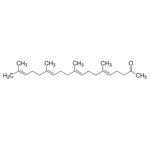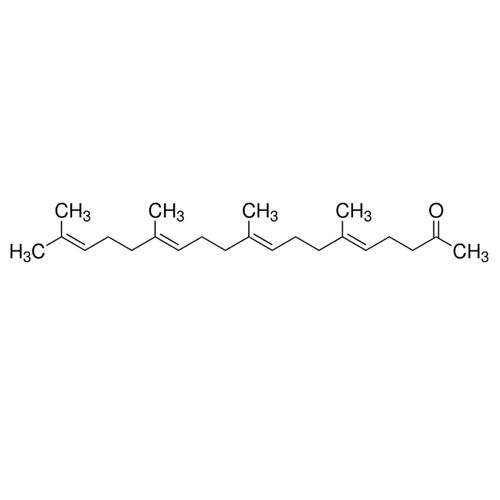| Product Name | Teprenone |
| Description |
HSP70 Inducer |
| Purity | >95% (GC) |
| CAS No. | 6809-52-5 |
| Molecular Formula | C23H38O |
| Molecular Weight | 330.6 |
| Field of Use | Not for use in humans. Not for use in diagnostics or therapeutics. For in vitro research use only. |
Properties
| Storage Temperature | -20ºC |
| Shipping Temperature | Shipped Ambient |
| Product Type | Inducer |
| Solubility | Soluble in DMSO (30 mg/ml) |
| Source | Synthetic |
| Appearance | Colorless Oil |
| SMILES | CC(=CCC/C(=C/CC/C(=C/CC/C(=C/CCC(=O)C)/C)/C)/C)C |
| InChI | InChI=1S/C23H38O/c1-19(2)11-7-12-20(3)13-8-14-21(4)15-9-16-22(5)17-10-18-23(6)24/h11,13,15,17H,7-10,12,14,16,18H2,1-6H3/b20-13+,21-15+,22-17+ |
| InChIKey | HUCXKZBETONXFO-NJFMWZAGSA-N |
| Safety Phrases |
Classification: Not a hazardous substance or mixture. Safety Phrases: S22 - Do not breathe dust. S24/25 - Avoid contact with skin and eyes. S36/37/39 - Wear suitable protective clothing, gloves and eye/face protection. |
| Cite This Product | Teprenone (StressMarq Biosciences Inc., Victoria BC CANADA, Catalog # SIH-526) |
Biological Description
| Alternative Names | Geranylgeranylacetone, GGA, 6,10,14,18-Tetramethyl-5,9,13,17-nonadecatetraen-2-one |
| Research Areas | Cancer, Cell Signaling, Heat Shock, Neuroscience |
| PubChem ID | 5282199 |
| Scientific Background | Teprenone can induce expression of HSP70, HSPB8, and HSPB1. Induction of HSP70 expression is protective against the development of various diseases, such as inflammatory bowel disease, hypoxic/ischemic brain injury and spinal and bulbar muscular atrophy (cytoprotective and anti-inflammatory effects) (1, 2). Reports indicate that Teprenone protects against NSAID-induced gastric and intestinal lesions by induction of HSP70 expression (2). Other studies have shown that it induces expression of HSPB8 and HSPB1 and reduces the formation of amyloid oligomers as well as insoluble aggregates in HSPB5 R120G TG mice (3, 4). |
| References |
1. Kobayashi T., Ohta Y., Yoshino J and Nakazawa S. (2001) Pharmacol Res. 43(1): 23-30. 2. Sambroski P., Grzymislawski M. (2015) Adv Clin Med. 24(3): 525-530. 3. Marunouchi T., Inomata S., Sanbe A., Takagi N., Tanonaka K. (2014) Eur J Pharmacol. 730: 1401-47. 4. Sanbe A., et al. (2009) PLoS One. 4(4): e5351. |



Reviews
There are no reviews yet.